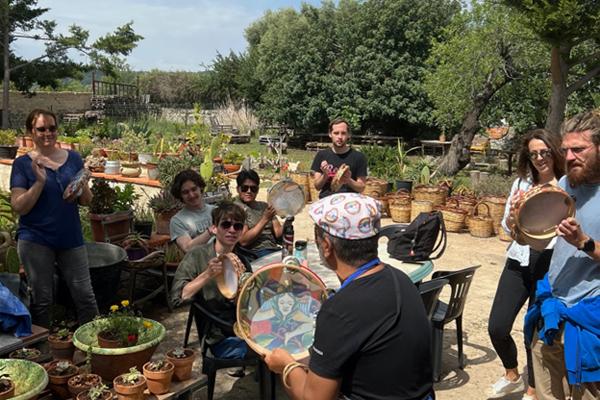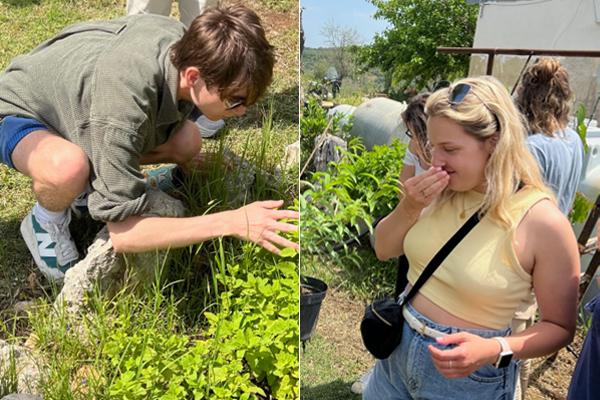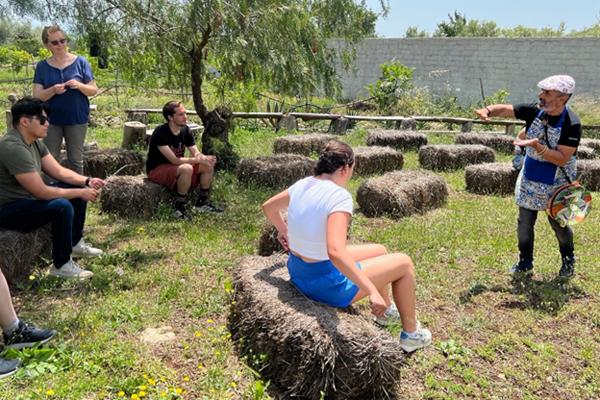
学生们看到移民如何改变了西西里,因为融合威胁了它的身份

在意大利锡拉库萨以东仅20英里的海布拉恩山脉古山城Palazzolo Acreide的公社别墅公园里,有一座雕像,纪念许多移民的当地人以及移民对后代的影响。
On one side of the statute, visitors see the immigrant’s arm and leg dressed in threadbare clothes and rough working boots, carrying a beat-up suitcase held together by rope. On the statue’s other side, the arm and leg are now dressed in smart city clothes with polished leather shoes and a modern new briefcase.
从一个贫穷的旅行者到一个成功的人的转变的辛酸在观看这件艺术品时立即被感受到。事实上,正如最近的一位参观者,俄亥俄大学的护理学生Liz Meserini在她为西西里的食物项目写的反思日记中所记录的那样,“我觉得和这座雕像有联系,因为我的曾祖父从西西里搬到美国时几乎一无所有,现在我有了这个神奇的生活。”
Part of Meserini’s amazing life this summer included joining other OHIO students on the May study away program, Food in Sicily. In addition to Palazzolo Acreide’s beautiful town park, the students' in-depth experience of Sicilian food and culture took them to Claudio Romano’s Agriteatro Sensoriale: an immersive farm experience in the sounds, smells, tastes, and tactile elements of this part of Sicily.
Romano is one of the many Sicilians who left the island, migrating north for employment. But, unlike others, he returned to the Iblei Mountains with his partner, Rossella Di Brigida, not to display newly found immigrant wealth but to reclaim the richness of his cultural roots by designing the Agriteatro Sensoriale at their family farm, Casa Contadina Iblea.
海布拉恩山脉(Hyblaean Mountains,意大利语叫Monti Iblei,西西里叫mont 'Ibblei)位于西西里岛东南角的锡拉库萨和拉古萨之间,由低矮的山脉组成,陡峭的峡谷和山谷被起伏的石灰岩山丘所取代,角豆树、杏仁树林和葡萄园被低矮的干石墙隔开。First settled by the Siculi, one of Sicily’s three ancient tribes, who arrived circa 1200 BCE and then four centuries later by the Greeks as an integral part of Magna Graecia, followed by the Romans, the Hyblaean Mountains are dotted with ancient archaeological sites. The origin of the name is disputed, with one tradition claiming the name is derived from the ancient King Iblone who ceded this part of his kingdom to the Greeks or from the Siculian divine mother goddess, Ibla, who protected fertility and brought abundance to the land and its inhabitants.
当“西西里美食”项目的学生们第一次来到卡萨·康塔迪娜·伊布莱时,罗马诺用他的手鼓或小手鼓为大家演奏了西西里歌曲。Then he invited the students to join in, passing out tamburellos and instructing the students in how to strike the drum using the palm, fist, and fingers. Everyone quickly found out that Sicilian tambourine drumming is far more complex than it looks, and as Romano explained, the tamburello is not only an instrument used to accompany song and dance, but also an essential element in Sicilian storytelling, fables, and poetry, for through the goat skins of the drum head not only does the animal still speak, but everyone who is gathered also hears the voice of the Great Mother, Ibla herself.
跟着tamburello的原始声音,学生们探索了香草花园和植物苗圃,在那里罗马诺种植药用和烹饪草药和植物——藏红花、柠檬香、鼠尾草、百里香、薄荷、迷迭香等等。20多年前,他开始收集野生草药,起初只是作为消遣。His neighbors nicknamed him arreniaturi or arrichinista, referring to him as “the one who forages wild oregano.”
“Everyone took me for a fool,” he recalled. “Everyone said I was the village idiot.” But Romano knew that the herbs he collected were essential in traditional remedies and folk medicine. As he led the group through his extensive garden, he encouraged everyone to run their hands across the plants, to feel the textures of the leaves and stems, and to breathe in deeply the aroma of each plant. The smells and textures of the plants are key components of his Agriteatro Sensoriale.
Every experience on the farm is part of the Agriteatro Sensoriale, and Romano and Di Brigida have also created a small theater in the round, with straw, wood and stone seating. 在这里,罗马诺为他的听众朗诵西西里方言诗歌、古老的民间故事和童谣,所有这些都是岛上讲故事的传统,旨在帮助他们在为农场编织篮子时打发时间。西西里语是在多年的征服、占领和外来影响下形成的。
Unlike Italian, which is almost entirely Latin-based, Sicilian contains elements of Greek, Arabic, French, Catalan, and Spanish and differs grammatically from Italian. Since 1860, when Sicily became a part of a newly unified country of Italy, there has been the feeling that the Sicilian language is not sustainable and will eventually die out due to the influx and influence of Italian. 对罗马诺来说,他的诗歌和讲故事是一种保护濒危语言和文化的行为:“我讲的童谣提到了所有已经失去的东西。The words represent our identity, our land.”
西西里人的身份和这片土地的丰饶也充斥了午餐桌上。Students enjoyed homemade savory tarts and fresh cheeses along with bitter greens and tomatoes dressed with the farm’s own olive oil and vinegar. It was a spectacular way of tasting the cultural foodways of the island.
“这无疑是我最喜欢的午餐,”空军国民警卫队的护理系学生、中士加布里埃尔·多泽(Gabrielle Dozer)说。“这是我吃过的最正宗、最美味的一顿饭。Eating and drinking all that food from the farm was just what I needed!”
Russ College of Engineering and Technology Cutler Scholar Orlando Gonzalez noted that the attention and skill that Romano and Di Brigida put into making the meal, “the way they prepared the food for us was magnificent, the flavors were so carefully prepared and generously shared, in a way that they appeared to not only be mere food but were bridges that connected the family that prepared them, their work, their knowledge and their values.”
Romano and Di Brigida are also master weavers, working with olive, willow, cane, broom, myrtle and carob, which they forage themselves, to fashion containers called “panaru” in Sicilian for carrying food such as lemons, grapes, olives, and bread. 篮子也用来储存和陈化食物,如乳清干酪、乳清干酪和其他奶酪,甚至用来发酵面包,这样面包就有了篮子的形状和格子,也有了甘蔗的味道。在西西里岛的各个城市,人们仍然可以经常看到帕纳鲁被绑在绳子上,从阳台上被吊到下面的街道上。
Basket weaving is an ancient tradition, going back centuries in Sicily to the time when baskets were made inside the family circle, during wintertime, as bad weather made fieldwork impossible. “我喜欢编织,”罗马诺告诉我们,“这是一种激情,但这是我们从祖先那里继承来的一种身份。”What’s more, Romano explains that like humans, no two baskets are the same. “每个篮子都有灵魂,因为木头是活的。”材料和我必须找到合二为一的方法。你伤了手,你割伤了自己,但创作总是不一样的。” (Watch Romano and Di Brigida making panaru and talking about the art of Sicilian basket weaving.)
Di Brigida helped students select suitable branches and with their help wove everyone a made-to-measure bracelet, "u vrazzalettu,” or ring, "l'aneddu.” Romano accompanied the weaving with some music, but this time he brought out his zampogna or ciaramèddha in Sicilian. The ciaramèddha is a type of zampogna or Italian bagpipe found throughout Italy, but especially popular in Sicilian folk music, and specifically in mountainous regions where sheep and goat herding are prevalent. The air bag of the zampogna is made from the complete hide of a sheep or goat. At slaughter, the hide is carefully removed in one piece, dried and treated (like drum skins are), and turned inside out so that the full coat of the animal is left intact inside the bag. One front leg and both rear legs are tied to contain the air while the remaining front leg is used as the air canal through which the player’s breath travels to fill the air bag and then release it upon playing. The ciaramèddha is one of the principal instruments along with the tamburello used in communal dances like the tarantella. For more about the zampogna and to hear what it sounds like, check out David Marker’s film, “Zampogna: The Soul of Southern Italy.”
在农场的一天结束时,我们上了一节传统的冷制皂课。Di Brigida uses the olive oil left over from last year’s harvest and mixes it with caustic soda and water. 然后,从农场广阔的花园中采摘的草药和精油被添加到最终产品中。她在附近的市场出售香皂,她最常要求的是玫瑰、金盏花、薰衣草和迷迭香的香味。很难不认为肥皂是理所当然的,但正如拉斯工程技术学院卡特勒学者加文·摩根所观察到的那样,“学习肥皂制作背后的化学原理让我发现,要做到完美比我想象的要难一点!”
随着一天的结束,学生们感谢他们的主人,他们鼓励他们收集一束芬芳的草药来提神,并为他们的巴士回城之旅做好准备。
While the day at Agriteatro Sensoriale concluded the three weeks of Food in Sicily’s experiential learning, the students carried home with them the flavors of Sicily and the knowledge that as Morgan said, “The memories made and relationships strengthened just over a table of food proves the power that food holds.”
关于西西里美食计划,2024年5月8日至28日
请联系大卫·贝尔,西西里美食研习计划主任,网址为belld@ohio.edu,了解更多信息或访问西西里美食主页。Join an info session via Teams.
信息通过团队会议
9月20日,星期三,晚上7:30
10月18日,星期三,晚上7:30
周三,11月15日晚上7点半。
12月13日,星期三,晚上7:30





